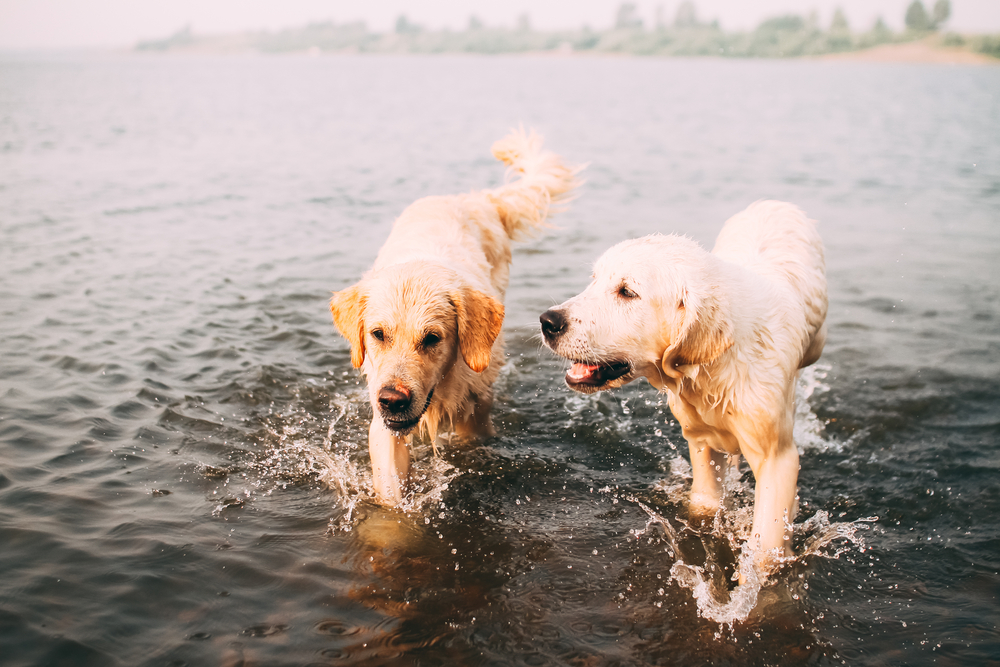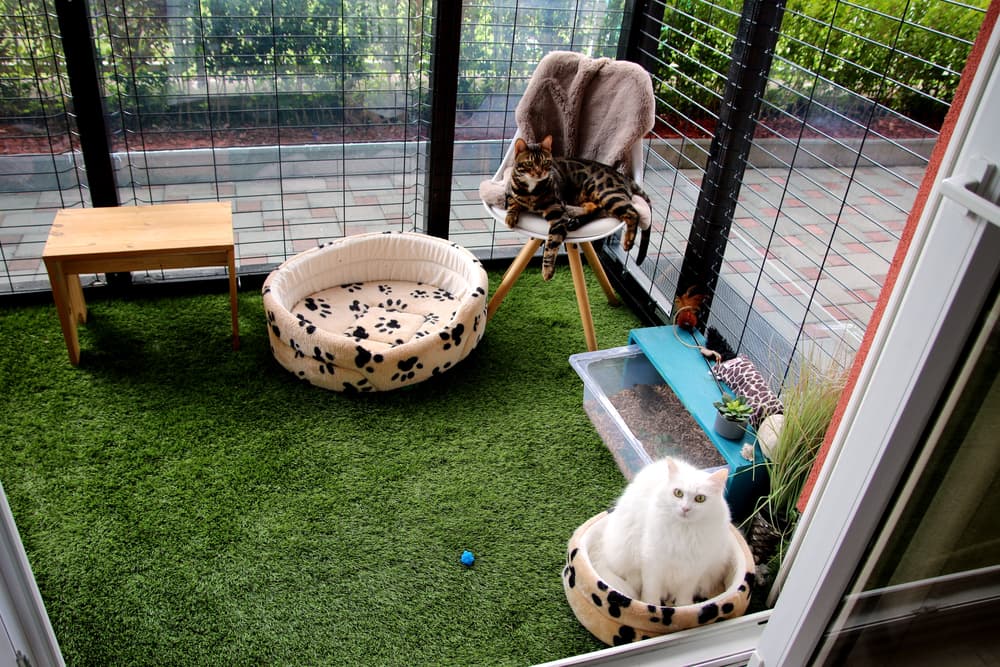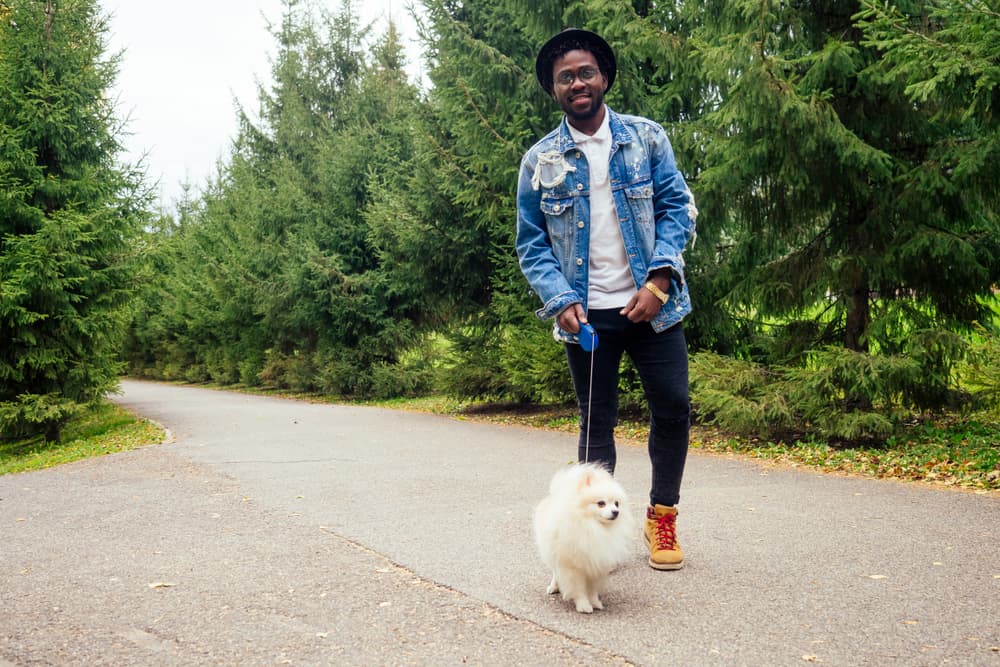Preparing for Outdoor Activities With Your Pet

As the days grow longer and the weather gets nicer, many of us are eager to explore the great outdoors. After months of being cooped up inside, summer gives us the perfect excuse to get out and get active again. It’s also the perfect time for an adventure with your dog or cat.
When you’re deep into planning a trip to the beach, an epic hike, or a neighborhood cookout, pet safety may bot be the very first thing on your mind. However, it’s important to be aware of potential dangers lurking outside to keep your pet safe.
Read on to learn how to prepare for outdoor activities with your pet…and keep them safe!
The Great Outdoors: Dangers for Pets

With a little planning, it’s easy for you and your pet to have plenty of summer fun while staying safe. For starters, know what dangers are out there:
Parasites
Summer is prime time for your dog to pick up hitchhikers like fleas and ticks as well as heartworm, says Irith Bloom, a certified professional dog trainer based in Los Angeles, California. To decrease your pup’s risk of picking them up, make sure he’s up to date on vaccinations and taking regular preventative medications as needed for your area (or wherever you plan to visit!).
The Heat
Your dog could get heat stroke even when the weather seems fine to you, says Bloom. Overweight or short-nosed dogs like Bulldogs and Pugs are at an increased risk of overheating, so keep them inside with the A/C on hot days.
Otherwise, know the signs of heat stroke: Excessive panting, difficulty breathing, and wobbliness or collapse are all indicators that you’re in the danger zone. If this happens, get your pup inside, cool him off with water, and head for your veterinarian’s office for help ASAP.
Hot Surfaces
It’s easy to forget thanks to sandals or tennis shoes, but concrete, asphalt, dirt, and sand can be extremely hot on a summer day. These surfaces can even burn your poor dog’s paw pads, says Bloom. I
f you know this is a possibility where you’re going (think: the beach, your local farmer’s market, or your neighborhood greenway), check the ground with the palm of your hand and choose a different path if it’s too hot. Then, next time, strap on dog booties to protect your pup’s paws.
Sunburn
It’s true: If your dog is hairless or has a light-colored nose or coat, he could be at risk for sunburn. Dog-friendly sunscreens or protective clothing can help ward off harmful UV rays, so ask your veterinarian what they’d recommend for your fellow adventurer.
Flora and Fauna
While it’s exciting to explore new areas, toxic plants like lily of the valley and foxtails as well as wild animals like bears, alligators, snakes, and hornets can all pose immediate danger to pets. Before venturing out, make sure to research where you’re going, stay alert, and keep your pup on a tight leash.
Outdoor Activities With Pets: Have a Blast and Be Safe

Now that you’re aware of what’s out there, ensure that quality time with your pet during the summer is as safe as possible. Here, a few ways to do just that, depending on the activity:
Hiking
If you’re out of shape, going on a hike can be exhausting, so first, ask yourself if your pup is healthy and fit enough to take on the trail you have in mind.
Then, check out guidelines for where you plan to go, as many U.S. National Parks trails are not dog-friendly or require your pup remain on a six-foot leash at all times (for their safety!), per the National Park Service (NPS).
Make sure to bring along plenty of water and dog-friendly snacks for fuel, dog booties for rough terrain, and poop bags so you leave no trace. After your hike, take advantage of downtime to check for and remove any burrs or ticks.
Long Summer Walks
“Long walks, like hikes, can mean hot air and hot pavement,” says Bloom. As such, you’ll also want to bring along lots of water, consider dog booties, and take into account your dog’s fitness level, especially if you have a puppy or elderly dog, she says.
To avoid the worst of summer heat, take your dog out in the early morning or late evening and choose a walking path with plenty of shade for breaks.
Swimming and Boating
Nothing beats a long day on the lake with a water dog. First, make sure your dog knows how to swim in advance of heading out on the water. To keep your doggy-paddler safe, stick to designated swimming spots and outfit him with a snug life jacket before he hops on a boat, as even the strongest swimmers can struggle if they fall overboard, says Bloom.
Make sure to keep your dog hydrated with lots of water and do not let him lap up any water from the lake, ocean, or puddles, as it can contain harmful bacteria, parasites, algae, and salt which can lead to sickness and dehydration.
When you’re done splashing about, rinse him off and dry his ears thoroughly to avoid infection.
Backyard Barbecues
Fire, matches, lighter fluid, strangers, food, oh my! With all of the above, cookouts can prove surprisingly stressful and dangerous for dogs and cats. First get a handle of your guest list. If you are planning on having (or attending) a socially-distant soiree with lots of people, think about how your pet reacts around strangers, children, or other animals. If he doesn’t do well, it’s kinder to him (and your friends) to leave your pup at home or secure your dog or cat in a dedicated room while you have company.
Another concern is that food-focused doggos may risk burning themselves on the grill for a nice piece of meat or eating something dogs should never eat like chocolate, onions, garlic, or corn on the cob (which can, in the worst-case scenario, cause intestinal blockages). In this case, keep your foodie on a tight leash or, again, leave him in a quiet space in your home.
If you do suspect your pet has gotten into something (or could in the future), keep your veterinarian, the closest emergency veterinary clinic, and the Animal Poison Control Center hotline in your contacts at (888) 426-4435.
Cat Catio Exploration
Adventure time is not *just* for dogs! If your cat loves the great outdoors too, a well-designed catio makes for a low-risk activity, says Bloom. Before you take her outside, though, make sure the barriers or mesh screens to the catio are well-secured so she can’t wriggle out. Then, set up multiple levels for her to explore so she can survey the world from high and low.
Road Trips
The goal of a road trip with your dog is to feel wild and free, but to keep the mood light, some precautions are in order. First, a proper ID is a must. “Collar tags, as well as a microchip, can make the difference between being reunited with your pet or never seeing him or her again,” says Bloom. (Scary, yes, but so important to remember).
Unsecured pets in a car can also turn into a nightmare, so make sure to crate your pet and secure the crate completely or opt for a Center for Pet Safety-approved car harness, suggests Bloom. Then, pack plenty of treats, food, water, bowls, pet shampoo and towels, and an extra leash and collar just in case yours breaks. If you suspect your dog may have car sickness, check in with your veterinarian before you hit the road.
Finally, no matter the adventure, never leave your pet alone inside your car. Even if your windows are cracked and it seems not-so-hot to you, temperatures can rise almost 20 degrees in just 10 minutes, which could put your pet at risk of severe illness and even death.
Outdoor Fun: How to Reduce Anxiety and Stress

Going outside means potential exposure to all sorts of stressors including new situations, strangers, animals, crowds, and loud noises. In light of this, keep in mind that some anxiety-prone pets are happier staying at home—and that’s okay, says Bloom.
Otherwise? For pets that are relatively comfortable exploring, treats can help build a positive association between the great outdoors and yummy food, says Bloom. If you have any concerns about your pet’s comfort level, though, consult with your veterinarian and consider asking for a referral to a certified professional dog trainer or veterinary behaviorist for additional help.
Sometimes, calming medications and supplements can help ease your pup’s anxieties to allow them to better enjoy summer fun with you.









